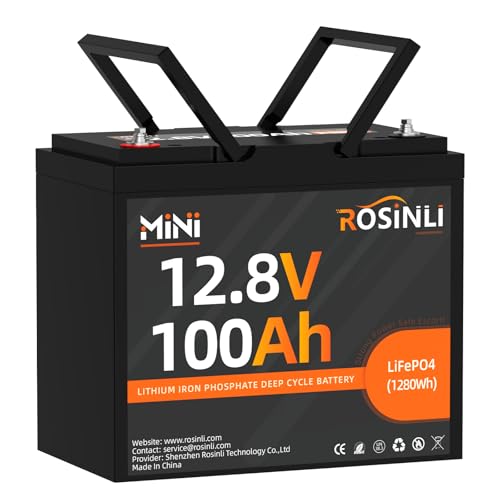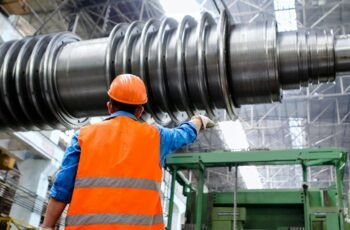If we’re planning off-grid power in 2025, three 12V 100Ah LiFePO4 batteries stand out for dependable, low-maintenance energy. Each offers about 1.28 kWh, built-in BMS protection, and flexible 4S/4P configurations for 12–48V systems. We’ll compare charging at 14.6V, 20A guidance per unit, cycle life, size, and warranties—plus where each model fits best, from RVs and solar to trolling motors and backups. The differences might surprise us.
Key Takeaways
- Mini LiFePO4 12V 100Ah: 20.9 lbs, compact, built-in BMS, flexible charging, supports up to 4S/4P, ideal for RV, marine, solar, and backup.
- Group 24 12V 100Ah: true drop-in fit, 100A BMS, ~1.28 kWh, up to 15,000 cycles, great support; avoid unadjustable legacy chargers.
- 4-Pack 12V 100Ah: scalable to 48V/400Ah, Grade-A cells, 4000+ cycles, wide temp range; equalize each to 14.6V before wiring.
- Safety and longevity: built-in 100A BMS protections, low-temp charge cutoffs, LiFePO4 charging profile (14.6V/20A), not for engine starting.
- Off-grid practicality: light weight, Group 24 compatibility, easy series/parallel scaling, reliable for RVs, trolling motors, UPS, and home storage.
12V 100Ah Mini LiFePO4 Battery with Built-in BMS for RV, Marine, Solar, and Home Energy Storage
November 19, 2025 4:07 pm
Looking for a compact 12V 100Ah that still delivers serious off‑grid power? We like this Mini LiFePO4 for its small footprint (5.4D x 9.2W x 8.35H) and light 20.9 lbs build. It’s energy‑storage focused, not for engine starting, and fits RV, marine, solar, camping, trolling motor, and home backup roles.
It packs automotive‑grade cells, a smart BMS (over‑charge/discharge, over‑current, short‑circuit), and supports up to 4S or 4P—max 48V (51.2V) or 400Ah. Charge with a LiFePO4 charger (14.6V/20A recommended), solar controller, or alternator. Users praise fast charging and retention. Note F2 terminals. Warranty: 5 years, 30‑day return, responsive support.
Best For: RV, marine, and off-grid users who need a compact, lightweight 12V 100Ah LiFePO4 battery for energy storage (not engine starting) with flexible series/parallel expansion.
Pros:
- Compact and light (5.4D x 9.2W x 8.35H; 20.9 lbs) with automotive‑grade cells and high energy density
- Built-in smart BMS for over-charge/discharge, over-current, and short-circuit protection; supports up to 4S or 4P (max 48V/400Ah)
- Versatile charging options (14.6V/20A LiFePO4 charger recommended, solar controller, or alternator); strong user feedback on fast charging and retention
Cons:
- Not suitable for engine starting applications
- F2 terminals may require adapters or compatible connectors for some setups
- Mixed user reports on warranty/service responsiveness despite 5-year coverage
12V 100Ah LiFePO4 Lithium Battery (Group 24, Built-in 100A BMS)
November 19, 2025 8:45 pm
Need a compact, Group 24 drop-in that still delivers serious off-grid power? We like this 12V 100Ah LiFePO4 with a built-in 100A BMS. At just 20.9 lb, it’s about 50% lighter than lead-acid yet stores 1.28kWh—roughly 2–3× the usable energy of similar SLA. It fits standard Group 24 trays, integrates easily in RVs, trolling motors, and home systems, and supports series/parallel expansion—up to 51.2V (4 in series) and unlimited parallel, reaching 20.48kWh.
The Grade A+ cells and smart BMS guard against over/under-voltage, over-current, shorts, and temperature extremes. Charge at 14.6V. Expect up to 15,000 deep cycles, a 10-year lifespan, and 24/7 support with a 24-month warranty.
Best For: RV owners, off-grid campers, small home solar users, and anglers needing a compact Group 24 drop-in battery with high usable energy, light weight, and expandable capacity.
Pros:
- Lightweight 20.9 lb Group 24 form factor with 1.28kWh—about 2–3× usable energy vs similar SLA
- Built-in 100A BMS with comprehensive protections; supports 4S (up to 51.2V) and unlimited parallel expansion (up to 20.48kWh)
- Long lifespan (up to 15,000 cycles/10 years) with 24/7 support and 24-month warranty
Cons:
- Charging requires 14.6V LiFePO4-compatible charger; not ideal with unadjustable legacy chargers
- Low-temperature limits: charging cut-off below 32°F and discharge cut-off below -4°F
- 100A max continuous discharge may be insufficient for very high surge/continuous loads without multiple batteries
4 Pack 12V 100Ah LiFePO4 Lithium Batteries with Built-in 100A BMS (5120Wh)
November 19, 2025 12:55 pm
For modular off-grid systems that demand safe, scalable power, this 4 Pack 12V 100Ah LiFePO4 with built-in 100A BMS stands out. Each 24.2 lb module delivers Grade‑A LiFePO4 performance with 4000+ cycles, robust protections, and a wide -20 to 60°C discharge range. We can run them in series up to 48V or in parallel up to 400Ah, ideal for home storage, UPS, RVs, trolling motors, and trailers.
Charge each battery to 14.6V with a 20A charger before first use, equalize voltages for 2–3 hours, then wire. If imbalance appears, fully recharge and consider a voltage equalizer. Not for engine starting.
Best For: Off-grid homeowners, RV/van owners, and backup power users who need safe, modular LiFePO4 storage that can scale in series to 48V or in parallel to 400Ah.
Pros:
- Built-in 100A BMS with protections (overcharge, over-discharge, over-current, short circuit) and Grade-A LiFePO4 cells with 4000+ cycles
- Flexible configuration: up to 4 in series (48V) or 4 in parallel (up to 400Ah), wide discharge temp range (-20 to 60°C)
- Lightweight (24.2 lbs each), high energy density, suitable for home storage, UPS, RVs, trolling motors, and trailers
Cons:
- Not suitable for engine starting; energy storage only
- Requires proper initial charging (14.6V, 20A per battery) and voltage equalization before wiring
- Parallel/series limited to 4 units; may need a voltage equalizer if imbalance occurs
Factors to Consider When Choosing 100AH Lifepo4 Batteries 12V
As we compare 12V 100Ah LiFePO4 options, we’ll check usable capacity and stable voltage alongside robust BMS protections. We’ll weigh cycle life and charging requirements to match your charger, solar setup, and expected duty cycle. We’ll also consider size and weight so the battery fits your space and meets portability needs.
Capacity and Voltage
Why does “12V 100Ah” matter so much? Because it tells us both how much energy we can store and the system voltage we’ll integrate with. A 12V 100Ah LiFePO4 delivers about 1.28 kWh, thanks to its nominal 12.8–13.2V range. Unlike lead-acid, LiFePO4’s flat discharge curve keeps voltage steadier, so we get more usable capacity.
In real use, we can typically draw 80–100Ah before recharging, depending on depth of discharge targets. Need more runtime? Parallel four 12V 100Ah batteries for 400Ah (about 5.1 kWh) at 12V. Need higher system voltage? Wire four in series for ~48V while keeping 100Ah.
To achieve rated output, we must match voltages and maintain proper series/parallel balance; under load, cell balance affects effective capacity.
BMS Protections
Voltage and capacity only pay off if the battery’s brain—the BMS—keeps the pack safe and consistent. We look for a built-in BMS that blocks overcharging, over-discharging, over-current, and short circuits, because these faults quickly damage cells and gear. Temperature protections matter, too. A good BMS monitors pack temps and will halt charge or discharge when conditions exceed safe limits. Low-temperature charge cutoff is essential for winter use, while high-temperature protection helps prevent thermal runaway under heavy loads or hot climates.
We also value balance management. By equalizing cell voltages during charging, the BMS maintains uniformity across cells—critical when running batteries in series or parallel. Finally, check current specs: maximum continuous discharge (often around 100A) and safe charge current limits ensure your system stays within design boundaries.
Cycle Life Ratings
How long will a 12V 100Ah LiFePO4 actually last? We should look at cycle life ratings. Most quality packs promise roughly 4,000 to 15,000 deep cycles when used within recommended conditions—far beyond lead‑acid. But those numbers hinge on how we use them. A stated “4,000+ cycles” often assumes modest depth of discharge, controlled temperatures, a compatible charger, and an effective BMS.
If we regularly drain to lower depths of discharge and keep temperatures in the specified range, we preserve more cycles. Cold conditions reduce efficiency and can shorten usable cycles, so we should plan accordingly. Manufacturers may tout 10‑year lifespans or very high cycle counts, yet real results depend on our patterns: discharge depth, temperature exposure, and overall care. Compare ratings, then match them to your usage.
Charging Requirements
To turn those cycle-life promises into real years of service, we need to charge LiFePO4 correctly. We look for chargers that target 14.6V with about ±0.2V tolerance. A dedicated LiFePO4 charger—or a solar controller with a LiFePO4 profile—prevents overcharge, hits the right absorption voltage, and stops early float that can stress cells.
We also respect temperature. Below freezing, we don’t charge; many BMSs enforce low-temp cutoffs, and we let them. For rate, fast charging is possible, but it can trim lifespan. A sensible default is a 20A charger for a 100Ah battery, scaling higher only when runtime demands justify it.
When wiring packs in parallel or series, we equalize first. Pre-charge to matching voltages so each battery shares work evenly.
Size and Weight
Weight and footprint matter when we’re packing power into tight spaces. A 12V 100Ah LiFePO4 typically weighs about 20.9 pounds (9.5 kg), far lighter than comparable lead-acid batteries. That drop in mass reduces strain on mounts and frames, a win for RVs, boats, and minimalist off-grid racks.
Most models use compact dimensions that fit standard trays—often a Group 24 footprint—so we can swap in without reworking compartments. The smaller case also makes handling, transport, and maintenance easier.
When we scale, the compact form factor shines. Stacking batteries in parallel or series stays manageable, preserving aisle space and airflow. We still get a full 12V nominal output, and built-in BMS protection keeps multi-battery arrays safe and stable while we add capacity without bulky compromises.
Conclusion
We’ve covered three excellent 12V 100Ah LiFePO4 options that deliver safe, maintenance-light power with solid cycle life, built-in BMS protection, and flexible 4S/4P scalability. Whether you want a compact single pack, a Group 24 drop-in, or a 4-pack for 5.12 kWh, you’ll get reliable performance, 14.6V charging, and sensible 20A per-unit charge guidance. Match capacity to your loads, plan wiring and protection, and you’ll enjoy dependable RV, marine, solar, and backup power for years.





